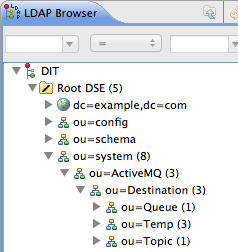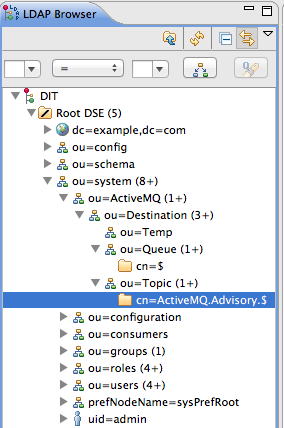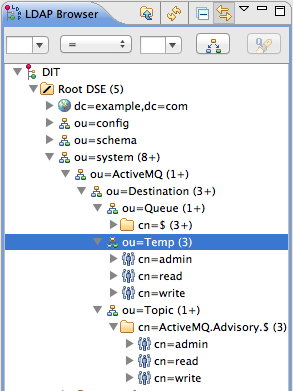Red Hat AMQ 6
As of February 2025, Red Hat is no longer supporting Red Hat AMQ 6. If you are using AMQ 6, please upgrade: Migrating to AMQ 7.Ce contenu n'est pas disponible dans la langue sélectionnée.
8.6. Add Authorization Entries
Overview
- Queue entries
- Each queue entry has a Common Name (
cn), which can be the name of a specific queue or a wildcard pattern that matches multiple queues. Under each queue entry, you must create sub-entries for the admin, read, and write permissions. - Topic entries
- Each topic entry has a Common Name (
cn), which can be the name of a specific topic or a wildcard pattern that matches multiple topics. Under each topic entry, you must create sub-entries for the admin, read, and write permissions. - Advisory topics entry
- In particular, you must define one topic entry with the Common Name,
ActiveMQ.Advisory.$, which is a wildcard pattern that matches all advisory topics. - Temporary queues entry
- A single
Tempentry contains the admin, read, and write permissions that apply to all temporary queues.
Using wildcards in queue and topic entries
| Wildcard | Description |
|---|---|
. | Separates segments in a path name. |
* | Matches any single segment in a path name. |
$ | Matches any number of segments in a path name. |
FOO.*, will match FOO.BAR, but not FOO.BAR.LONG; whereas the pattern, FOO.$, will match FOO.BAR and FOO.BAR.LONG.
$ character is used instead of the usual > character to match multiple destination name segments.
Steps to add authorization entries
- The next few steps describe how to create the
ou=ActiveMQnode.- Right-click on the
ou=systemnode and select. The New Entry wizard appears. - In the Entry Creation Method pane, select the Create entry from scratch radiobutton. Click Next.
- In the Object Classes pane, select
organisationalUnitfrom the list of Available object classes on the left and then click Add to populate the list of Selected object classes. Click Next. - In the Distinguished Name pane, complete the RDN field, putting
ouin front andActiveMQafter the equals sign. Click Next and then click Finish.
- The next few steps describe how to create the
ou=Destination,ou=Queue,ou=Topic, andou=Tempnodes.- Right-click on the
ou=ActiveMQnode and select. The New Entry wizard appears. - In the Entry Creation Method pane, select the Create entry from scratch radiobutton. Click Next.
- In the Object Classes pane, select
organisationalUnitfrom the list of Available object classes on the left and then click Add to populate the list of Selected object classes. Click Next. - In the Distinguished Name pane, complete the RDN field, putting
ouin front andDestinationafter the equals sign. Click Next and then click Finish. - In a similar manner to the preceding steps, by right-clicking on the
ou=Destinationnode and invoking the New Entry wizard, create the followingorganisationalUnitnodes as children of theou=Destinationnode:ou=Queue,ou=Destination,ou=ActiveMQ,ou=system ou=Topic,ou=Destination,ou=ActiveMQ,ou=system ou=Temp,ou=Destination,ou=ActiveMQ,ou=system
ou=Queue,ou=Destination,ou=ActiveMQ,ou=system ou=Topic,ou=Destination,ou=ActiveMQ,ou=system ou=Temp,ou=Destination,ou=ActiveMQ,ou=systemCopy to Clipboard Copied! Toggle word wrap Toggle overflow
- In the LDAP Browser window, you should now see the following tree:
Figure 8.3. DIT after Creating Destination, Queue, Topic and Temp Nodes
- The next few steps describe how to create the following nodes:
cn=$,ou=Queue,ou=Destination,ou=ActiveMQ,ou=system cn=ActiveMQ.Advisory.$,ou=Topic,ou=Destination,ou=ActiveMQ,ou=system
cn=$,ou=Queue,ou=Destination,ou=ActiveMQ,ou=system cn=ActiveMQ.Advisory.$,ou=Topic,ou=Destination,ou=ActiveMQ,ou=systemCopy to Clipboard Copied! Toggle word wrap Toggle overflow These nodes represent name patterns that match queue names and topic names, respectively. Thecn=$queue node defines an entry that matches all queue names, so it can be used to define access rights for all queues. Thecn=ActiveMQ.Advisory.$node defines a topic entry that matches all advisory topics.- Right-click on the
ou=Queuenode and select. The New Entry wizard appears. - In the Entry Creation Method pane, select the Create entry from scratch radiobutton. Click Next.
- In the Object Classes pane, select
applicationProcessfrom the list of Available object classes on the left and then click Add to populate the list of Selected object classes. Click Next. - In the Distinguished Name pane, complete the RDN field, putting
cnin front and$after the equals sign (where$represents the wildcard that matches any queue name). Click Next and then click Finish. - In a similar manner to the preceding steps, by right-clicking on the
ou=Topicnode and invoking the New Entry wizard, create the followingapplicationProcessnode as a child of theou=Topicnode:cn=ActiveMQ.Advisory.$,ou=Topic,ou=Destination,ou=ActiveMQ,ou=system
cn=ActiveMQ.Advisory.$,ou=Topic,ou=Destination,ou=ActiveMQ,ou=systemCopy to Clipboard Copied! Toggle word wrap Toggle overflow
- In the LDAP Browser window, you should now see the following tree:
Figure 8.4. DIT after Creating Children of Queue and Topic Nodes
- The next few steps describe how to create nodes that represent
admin,read, andwritepermissions for the queues and topics.- Right-click on the
cn=$node and select. The New Entry wizard appears. - In the Entry Creation Method pane, select the Create entry from scratch radiobutton. Click Next.
- In the Object Classes pane, select
groupOfNamesfrom the list of Available object classes on the left and then click Add to populate the list of Selected object classes. Click Next. - In the Distinguished Name pane, complete the RDN field, putting
cnin front andadminafter the equals sign. Click Next. - You are now prompted to provide a value for the mandatory
memberattribute, through the DN Editor dialog. In the text field, entercn=admin,ou=roles,ou=system. Click Ok.NoteThecn=admin,ou=roles,ou=systemreferences a role that was created for the Apache Karaf JAAS authentication plug-in in a previous tutorial. These roles can be reused by the Apache ActiveMQ authorization plug-in, under certain conditions. See the section called “Compatibility with Apache Karaf principals” for details. - Click Finish, to close the New Entry wizard.
- In a similar manner to the preceding steps, by right-clicking on the
cn=$node and invoking the New Entry wizard, create the following additionalgroupOfNamesnodes as children of thecn=$node:cn=read,cn=$,ou=Queue,ou=Destination,ou=ActiveMQ,ou=system cn=write,cn=$,ou=Queue,ou=Destination,ou=ActiveMQ,ou=system
cn=read,cn=$,ou=Queue,ou=Destination,ou=ActiveMQ,ou=system cn=write,cn=$,ou=Queue,ou=Destination,ou=ActiveMQ,ou=systemCopy to Clipboard Copied! Toggle word wrap Toggle overflow
- Copy the
cn=admin,cn=read, andcn=writepermission nodes and paste them as children of thecn=ActiveMQ.Advisory.$node, as follows.Using a combination of mouse and keyboard, select the three nodes,cn=admin,cn=read, andcn=write, and typeCtrl-Cto copy them. Select thecn=ActiveMQ.Advisory.$node and typeCtrl-Vto paste the copied nodes as children. - Similarly, copy the
cn=admin,cn=read, andcn=writepermission nodes and paste them as children of theou=Tempnode. - In the LDAP Browser window, you should now see the following tree:
Figure 8.5. DIT after Creating Children of Queue, Topic and Temp Nodes


